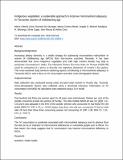| dc.description.abstract | Background/objectives
Increasing dietary diversity is a viable strategy for addressing micronutrient malnutrition in women of childbearing age (WCA) from low-income countries. Recently, it has been demonstrated that some indigenous vegetables (IV) with high nutrient density may help to ameliorate micronutrient’s intake. The Minimum Dietary Diversity index for Women (MDD-W) could be considered as a proxy to describe one important dimension of women’s diet quality. This cross-sectional study aimed at exploring aspects contributing to micronutrients adequacy in Tanzanian WCA, with a focus on IV consumption and other socio-demographic factors.
Subjects/methods
Data collection was conducted among urban and peri-urban women in Arusha city, Tanzania. Socio-demographic factors were collected using a structured interview. Information on IV consumption and MDD-W calculation were obtained using a 24-h recall.
Results
One-hundred and forty-one women aged 14–49 years were interviewed. Sixteen per cent of the sample consumed at least one portion of IV/day. The total median MDD-W was 4.0 (IQR. 3.0–5.0) and it was adequate in the 44% of the sample. Women who consumed IV had MDD-W 0.66 points (95% CI: 0.02–1.30, p = 0.046) higher than those who did not; consuming IV had an odds ratio of more than three times concerning women not consuming IV (OR: 3.30, 95% CI: 1.24–8.81, p = 0.017).
Conclusions
The IV consumption is positively associated with micronutrient adequacy and its absence from the diet can be an indicator of micronutrient deficiencies in vulnerable people such as WCA. For that reason, this study suggests that IV consumption may improve micronutrient deficiency in WCA. | en_US |

